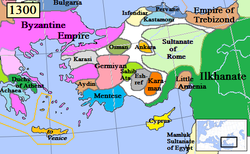Germiyan
Germiyan (bahasa Turki Anatolia Kuno: كرميان; bahasa Turki: Germiyanoğulları Beyliği atau Germiyan Beyliği) adalah sebuah beylik Anatolia terkemuka yang didirikan oleh suku-suku Turki Oghuz[1] (kemungkinan suku Afshar)[2] setelah kejatuhan Kesultanan Rûm. Namun, sementara beylik selalu disebutkan sebagai Turkoman atau Turki Oghuz, populasinya terdiri dari Turk dan Kurdi Yezidi, dibawa oleh dinasti Seljuk dari sebelah timur Malatya ke Anatolia barat sebagai milisi penjaga menghadapi ancaman-ancaman dari suku-suku Turki.[3][4][5][6][7]
Germiyan | |||||||||
|---|---|---|---|---|---|---|---|---|---|
| 1300–1429 | |||||||||
 Beylik Germiyan (merah terang) pada tahun 1300. | |||||||||
| Ibu kota | Kütahya | ||||||||
| Bahasa yang umum digunakan | Turki Anatolia Kuno | ||||||||
| Agama | Islam | ||||||||
| Pemerintahan | Monarki | ||||||||
| Bey | |||||||||
• 1300–1340 | Yaʿqūb I | ||||||||
• 1340–1361 | Muḥammad Chakhshādan | ||||||||
• 1361–1387 | Sulaymān Shāh | ||||||||
• 1387–1429 | Yaʿqūb II | ||||||||
| Era Sejarah | Abad Pertengahan Akhir | ||||||||
• Didirikan | 1300 | ||||||||
• Dibubarkan | 1429 | ||||||||
| |||||||||
Asal usul
suntingMenurut Agoston dan Masters, Germiyanoğulları adalah Turkoman yang bermigrasi ke barat akibat tekanan Mongol pada paruh kedua abad ke-13.[8] Germiyan termasuk dalam cabang Afshar dari Turk Oghuz.[9] Germiyan kemungkinan datang dari Kerman atau Provinsi Fars, mungkin menuju ke barat bersama Khwarazmshah. Setelah kematian Jalal ad-Din Mingburnu, mereka dikirim kembali ke wilayah Malatya untuk sementara, kemudian dipindahkan ke Kütahya, di mana mereka mendirikan beylik.[9]
Menurut sejarawan Timur Tengah bernama Petry, beylik Germiyan adalah sebuah dinasti Turki-Kurdi.[6] Namun, sejarawan budaya bernama Cemal Kafadar menyatakan komposisi etnik dinasti tersebut terlalu kompleks untuk interpretasi yang sederhana dan lugas.[10]
Referensi
sunting- ^ İnalcık, Halil (1993). The Middle East and the Balkans under the Ottoman Empire : essays on economy and society. Bloomington: Indiana University Turkish Studies. hlm. 97. ISBN 9781878318046.
- ^ Leiser, Gary; Koprulu, Fuat (1992). Origins of the Ottoman Empire. hlm. 37. ISBN 9781438410432.
- ^ Ducas, Harry J. Magoulias, Ducas, 1975 , Decline and fall of Byzantium to the Ottoman Turks, p. 265, Wayne State University Press, University of Virginia ISBN 0-8143-1540-2, ISBN 978-0-8143-1540-8, Germiyan kemungkinan merupakan campuran antara Kurdi dan Turki yang datang dari sebelah timur Malatya.
- ^ Peter Malcolm Holt, 1986, The Age of the Crusades: the Near East from the eleventh century to 1517, p. 176, Longman, University of Michigan, ISBN 0-582-49303-X, 9780582493032 The second of the eastern principalities, Germiyan, developed from a group, probably of mixed Kurdish and Turkish origin
- ^ Marios Philippides, Biblioteca apostolica vaticana - 1990, Byzantium, Europe, and the early Ottoman sultans, 1373-1513: an anonymous Greek chronicle of the seventeenth century, p. 6, A.D. Caratzas, University of Michigan, ISBN 0-89241-430-8, ISBN 978-0-89241-430-7, Near Byzantine borders in Phrygia, the emirate of Germiyan was formed by a mixed population of Turks and Kurds, who had come from east of Malatya
- ^ a b Carl F. Petry, 1998, The Cambridge History of Egypt, Vol. 1, p. 527, Cambridge University Press ISBN 0-521-63313-3, ISBN 978-0-521-63313-0, An Anatolian Turco-Kurdish dynasty, with its capital at Kutahya
- ^ Bruinessen, Martin van (1992). Agha, Shaikh and State: The Social and Political Structures of Kurdistan (dalam bahasa Inggris). Bloomsbury Academic. hlm. 161. ISBN 978-1-85649-018-4.
- ^ Gabor Agoston-Bruce Masters, Encyclopaedia of the Ottoman Empire, p. 41 ISBN 978-0-8160-6259-1
- ^ a b Mehmet Fuat Köprülü, (1937), The Origins of the Ottoman Empire, p. 37
- ^ Kafadar 2007, hlm. 22.
Daftar pustaka
sunting- Bosworth, Clifford Edmund (1996). New Islamic Dynasties: A Chronological and Genealogical Manual. Edinburgh University Press.
- Kafadar, Cemal (2007). "A Rome of One's Own: Reflections on Cultural Geography and Identity in the Lands of Rum". Muqarnas. Brill. 24: 7–25.
- (limited preview) Mehmet Fuat Köprülü (1992). The Origins of the Ottoman Empire. Diterjemahkan oleh Gary Leiser. State University of New York Press. ISBN 0-7914-0819-1.
- Varlık, Mustafa Çetin (1996). "Germiyanoğulları". TDV Encyclopedia of Islam, Vol. 14 (Geli̇bolu – Haddesenâ) (dalam bahasa Turkish). Istanbul: Turkiye Diyanet Foundation, Centre for Islamic Studies. hlm. 33–35. ISBN 978-975-389-441-8.

